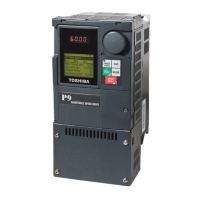P9 ASD Installation and Operation Manual 11
Power Factor Correction
DO NOT connect a power factor correction capacitor or surge absorber to the output of the P9 ASD.
If the P9 ASD is used with a motor that is equipped with a capacitor for power factor correction, remove
the capacitor from the motor.
Connecting either of these devices to the output of the P9 ASD may cause the P9 ASD to malfunction
and trip, or the output device may cause an over-current condition resulting in damage to the device or
the P9 ASD.
Light Load Conditions
When a motor is operated under a continuous light load (i.e., at a load of less than 50% of its rated
capacity) or it drives a load which produces a very small amount of inertia, it may become unstable and
produce abnormal vibration or trips because of an over-current condition. In such a case, the carrier
frequency may be lowered to compensate for this undesirable condition (see Program Special
Carrier Frequency PWM Carrier Frequency).
Note: When operating in the Vector Control mode, the carrier frequency should be set to
2.2
kHz or above.
Motor/Load Combinations
When the P9 ASD is used in combination with one of the following motors or loads, it may result in
unstable operation.
• A motor with a rated capacity that exceeds the motor capacity recommended for the P9 ASD.
• An explosion-proof motor.
When using the P9 ASD with an explosion-proof motor or other special motor types, lower the carrier
frequency to stabilize the operation, but DO NOT set the carrier frequency below 2.2 kHz if operating the
system in the vector control mode.
Note: When operating in the Vector Control mode, the carrier frequency should be set to
2.2
kHz or above.
If the motor being used is coupled to a load that has a large backlash or if coupled to a reciprocating load,
use one of the following procedures to stabilize motor operation.
• Adjust the S-pattern acceleration/deceleration setting,
• If operating in the Vector control mode, adjust the response time, or
• Switch to the Constant Torque control mode.

